Other Links
Editorial Board
- Editor - Bill Kenny
- London Editor-Melanie Eskenazi
- Founder - Len Mullenger
Google Site Search
SEEN
AND HEARD INTERNATIONAL SPECIAL FEATURE
Soli Deo Gloria, The Leipzig Bach Festival
2008:
A
special
three part report by Aart van der Wal - Part Two (AvW)
Part Two : The Music 17th - 20th June
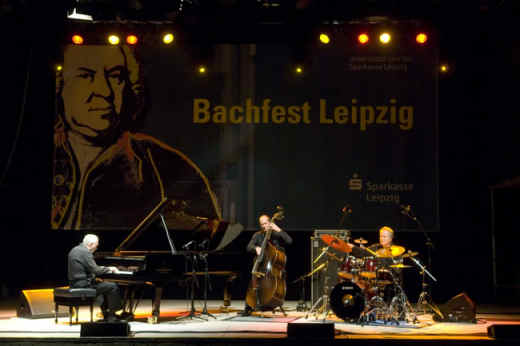 \
\
© Bach-Archiv Leipzig/Gert Mothes
Making choices…
The overall program was so diversified and extensive, that is
was impossible to attend all concerts and events; no-one can be
in
two places at the same time. Additionally , choices were often difficult to
make between for example a very promising performance and a full day
expert guided tour somewhere in Saxony under the Bach Archive’s
patronage. And not everyone, me included, could possibly be present
from day one (Saturday, June 14) for the opening concert in St.
Thomas’s Church, with Daniel Reuss conducting the Collegium Vocale
Gent in the 1725 ediition of Bach’s St. John Passion, with Christoph Prégardien (Evangelist and tenor arias),
Michael Volle (Jesus), Hana Blazíkova (soprano), Damien Guillon (altus)
and Peter Kooij (Pilatus and bass arias). Robert Schumann wrote on
2nd April 1849 in a letter to Georg Dietrich Otten about
this work: “Do you know Bach’s St. John Passion, the ‘little’ one,
as it is known? Doubtless you do! But don’t you find it so much
bolder, more powerful, more poetic than that according to the Gospel
of St. Matthew?” Whether or not Reuss proved the point, his
performance was not only lauded in the local newspapers, but also
highly praised in the streets and coffee houses for its great
textual transparency, zest and structural insight. I heard almost
everywhere that it had been a real gem in every aspect. Yes, I felt
remorse, I should have arrived on the 14th, instead of the 17th, but
on the other hand, I could look forward to the many
jewels still to come!
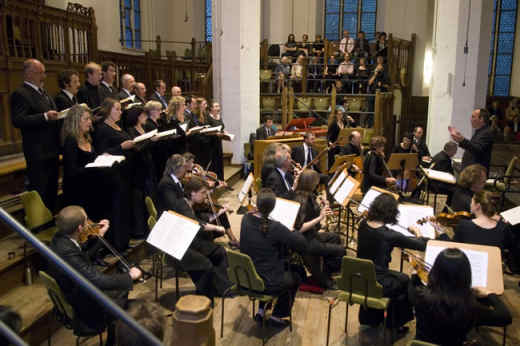
Daniel Reuss conducts CollegiumVocale Gent in
Bach’s St. John Passion in St. Thomas’s Church
©Bach-Archiv Leipzig/Gert Mothes
The first jewel:
a miraculous pasticcio in St. Thomas’s Church:
“Wer ist der, so von Edom kömmt” by Graun, Telemann and Bach
Carl Heinrich Graun composed the passion cantata “Ein Lämmlein geht
und trägt die Schuld” in Brunswick (Braunschweig) between 1725 and
1735. The work – also known as Graun’s “little passion” – was quite
popular in those days, as numerous copies of the score were passed
on, even far and wide in the 18th century. A copy belonged to Johann
Christoph Altnickol, which was later acquired by his brother-in-law
Carl Philipp Emanuel Bach, who finally listed it in his estate in
1790 as “A Passion by C.H. Graun, with splendid 4 and 5 part
chorales and fugues. Full score.”
The American scholar John W. Grubbs studied the score in 1965 and
found that this was definitely not the original version of Graun’s
cantata but a real pasticcio, with added movements by other
composers. Questions were raised about the author(s) of the
arrangement. In total 11 movements had been added, and in accordance
with the customary church services in Leipzig it was laid out in two
parts. The unknown arranger had used the Palm Sunday cantata “Wer ist
der, so von Edom kömmt” by Georg Philipp Telemann (TWV 1:1585) as
the prologue (aka exordium). The transition from the introduction
to the Passion’s action was constructed from the chorale “Christus,
der uns selig macht”, which also stemmed from Telemann’s cantata.
The second part contains nine movements by other composers,
including two or three by Johann Sebastian Bach, starting with the
massive chorale chorus from his cantata “Herr Jesu Christ, wahr’
Mensch und Gott” BWV 127, but now transposed from the original F
major to E flat major, and followed by a bass aria of unknown
authorship (although its style definitely points to Bach, as
is the case with the homogenous chorale movements). Two or three of
the additional movements were clearly composed by Bach, while the
contributions to the score by his pupil and son-in-law Altnickol
reveal that the pasticcio version itself does goes back to Bach directly,
or at least to his Leipzig circle.
The scale of
Bach’s participation in the creation of the final score
may be questioned, but the work gives us at least a few hints to one
of his lost Passions, and most probably his last one, at any rate
composed after 1733. The chorale chorus “Herr Jesu Christ, wahr’
Mensch und Gott” is not a copy of the autograph score of BWV 127,
but from a strongly revised version which itself can also have been
only written
by Bach himself. In this form the movement could have been taken
from the missing lost Passion, from which the bass arioso “So heb ich den
meine Auge sehnlich auf” was presumably “borrowed”. As for the
libretto's form, the vocal part – accompanied by two unidentified
instruments and continuo – recalls the tenor accompaniment in the
St. Matthew Passion “O Schmerz! Hier zittert das gequälte Herz”.
Whether or not Bach’s librettist Christian Friedrich Henrici (alias
Picander) had any hand in it needs further research.
Bach might also have taken part in the arrangement of the motet type
chorus “Der Gerechte kommt um”. The instrumental accompaniment
resembles close parallels with the chorale chorus “O Jesu Christ,
meins Lebens Licht” BWV 118. In any case, the working model adopted
here comes close to Bach’s arrangements of works by other composers
such as Johann Kaspar Kerll and Antonio Caldara.
Setting the musicological question marks aside, conductor David Timm
led an exuberant
performance with lots of drama on Tuesday, June 17, in St. Thomas’s
Church , but also conducted with really amazing
elegance and stylistic empathy. There were many delights to be
discovered in this illuminating score, fiercely paced and
accented, with crystal clear flutes and oboes and with the quite impressive
and opulent sonorities of bassoon and double bass almost absorbing
the spacious acoustic church setting. The highly spirited choral
contributions of the Cantores Lipsiensis made the most out of the
marvelous subtleties incorporated in this splendid and very colourful
work. The vocal soloists (Gesine Adler – soprano, Susanne
Krumbiegel – alto, Martin Petzhold – tenor and Gotthold Schwarz –
bass) showed exquisite refinement, perfect musical judgement and
great textual allure. The Pauliner Barockensemble excelled in
equally inspired contributions, with their light, fresh, supple and
secure tone. In short a most convincing performance.
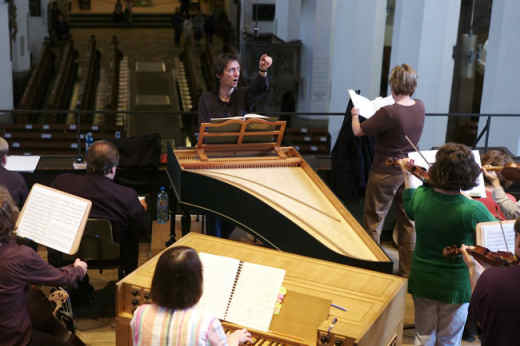
David Timm rehearses “Wer ist der, so von Edom
kömmt” from the cembalo in St. Thomas’s Church
©Bach-Archiv Leipzig/Gert Mothes
A
Cantata feast: Bach and Telemann in St. Nikolai’s Church
Bach’s chorale cantatas belong for the greater part to the second
Leipzig cycle. In most of these the chorale verses only figure in
the opening and closing chorales; the recitatives and arias in
between serve as a free exposition of the chorale verses. Although the
sacred cantatas were written for either the protestant church
service or for specific liturgical events, each and every one of
them holds its own unique character, far from the routine production
that one would expect under the circumstances in which Bach had to
produce a cantata for every week (apart from the previously
composed cantatas which he reused or adapted to suite the purpose).
A good example is the cantata which opened this concert: “Nimm von
uns, Herr, du treuer Gott” BWV 101 for the tenth Sunday after
Trinity, drafted for the performance in St. Thomas’s Church on
August 13, 1724. The vocal parts of the great opening chorale are
treated in the style of a chorale motet, with anticipating
imitations in the lower parts and with the cantus firmus line in
long stretched notes in the soprano voices. The brief orchestral
accompaniment is dominated by constantly recurring, insistent short
motifs which are so typical of Bach’s composing style. Another
feature are the clustered dissonances in moments of great distress,
as at “grosse Not” (“dire need”), a strong plea for salvation which cannot be missed.
The next work, Telemann’s sacred cantata “Herr, strafe mich nicht in
deinem Zorn” TWV 1:771, is rarely heard in public. The cantata was
composed for the nineteenth Sunday after Trinity and performed in
Hamburg for the first time in 1723. So it dates from the same period
as Bach’s cantata BWV 101, but the differences are nevertheless
striking. Before Telemann left Frankfurt Main in 1721 for Hamburg to
take up the position of cantor and music director of the city’s
principal churches, he had made the request to retain his citizenship
of Frankfurt, committing himself in return to send new music to
Frankfurt regularly, as is the case with this cantata,
first performed there in 1724. In contrast to Bach’s cantata, Telemann
opted for an introductory sinfonia, with the first part of the
opening psalm text ishaped as an arioso duet for alto and tenor
before the choir and the full orchestra participates in a quick
fugue (“Eile mir beizustehen”, “Hasten to help me”). The full
orchestra only returns in the simple but trumpet-heightened final
chorale, just after the cantata reaches its climax in the third
aria, in which the bass voice is supported by an unconventionally
drafted orchestral accompaniment, which clearly emphasises
Telemann’s great talents as a composer.
Even more rarely heard are the Misereres in C minor by Jan Dismas
Zelenka and Johann Adolph Hasse, both works being associated with
the Dresden Catholic court. The structures of the two settings are,
however, basically different. Hasse composed his Miserere, a
setting of an earlier Venetian arrangement for women’s voices only,
in the customary manner as a ‘number psalm’, comprising a series of
independent movements, unlike Zelenka who grouped all psalm
verses into one single movement. Only the subsequent doxology
“Gloria patri” is subdivided into individual movements and separated
from the psalm text. Compared to Hasse’s work, Zelenka’s setting is more
imaginative and expressive, but it was good to hear both works in an
excellent live performance like this.
The last work on the program, Bach’s sacred cantata “Herr, gehe
nicht ins gericht” BWV 105 for the ninth Sunday after Trinity was an
excellent choice in terms of formal and expressive contrasts. It is
one of Bach’s most peculiar cantatas, as is shown in the soprano
aria “Wir zittern und wanken der Sünder Gedanken”, without any
supporting bass fundamental, symbolizing that the sinner lacks stable
ground. Both violins play a persistent tremolo throughout the
movement, expressing the trembling (“zittern”), above which the two
responding melodic lines of the soprano and oboe waver (“wanken”),
further enhanced by long intervals and colourful register changes.
At the same time, strange harmonies pop up, especially at the word
“Folter” (torment), embedded in major and minor seconds. The closing
chorale with trembling tremolo string parts is also quite unusual.
Here, Bach refers to the previously heard soprano aria. However,
during its further course the ‘trembling’ diminishes and finally
come to rest completely.
The lofty splendor of the choral singing by the Dresden Chamber
Choir and the orchestral playing by the Dresden Baroque Orchestra in
tight focus made an overwhelming impression. A great compliment is also
due to the vocal soloists (Anna Prohaska – soprano, Susanne Langner –
alto, Hans Jörg Mammel – tenor and Henryk Böhm – baritone) for their profoundly felt treatments of the text, well characterized
singing and meticulous articulation. Hans-Christoph Rademann’s
conducting was another gem, with much attention to orchestral and
vocal balancing, crystal clear textures and fine dynamic shading.
The mystical, meditative nature of both Misereres was superbly
caught. I was also present at the rehearsal sessions and noticed
Rademann handling the spacious but recessed acoustics of St. Nikolai
most intelligently , resulting in a bright, sharply defined sound
picture that brought out vivid transparent lines in the multiple
vocal and instrumental parts. The entire program on Wednesday, June
18 was recorded by MDR for broadcast on July 26.
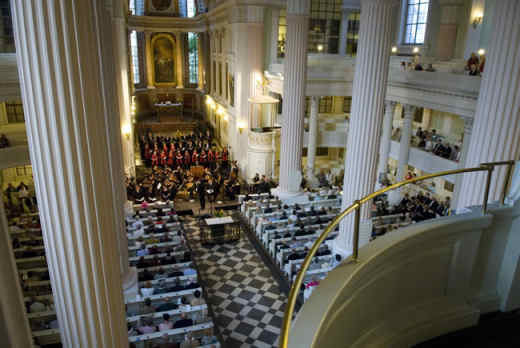
The Cantata feast in St. Nikolai’s Church: Hans-Christoph
Rademann conducts the Dresden Chamber Choir and the Dresden Baroque
Orchestra
©Bach-Archiv Leipzig/Gert Mothes
Sir Roger Norrington’s first concert in St. Thomas’s Church: Bach
and his sons
The program on Thursday, June 19th offered a mix of traditional and
daring works: Bach’s First Brandenburg Concerto in F major BWV 1046
and Mozart’s Symphony in E flat major KV 543 as the cornerstones,
and in between C.P.E. Bach’s Symphony in B minor Wq 182 No. 5 and J.Chr. Bach’s
Symphony in G minor Op 6 No. 6. It was all about
historical perspective: from Bach’s genial conventionality to C.P.E
Bach’s almost revolutionary break-through with his daring
symphonies. At the end of the same spectrum stands Mozart’s KV 543, the
first work of his final symphonic tryptich.
In the beginning of the 18th century the sinfonia or symphony was
still the short three-movement piece played as an introduction to a longer
Italian vocal work. The usual pattern was fast-slow-fast. Around
1720 the genre began to emancipate itself and to become an
independent instrumental piece. Half a century later it had reached
the status of the most important musical forms on the concert scene. Norrington’s choice
therefore, was all in all a very logical one.
At the very start of the concert the first of the six virtuoso
pieces which Bach wrote in 1721 for the margrave Christian Ludwig
von Brandenburg, did not sit well. Bach’s intention to have the
instruments (two horns, three oboes, bassoon, piccolo violin,
strings and basso continuo) competing with each other was not
adequately picked up by Norrington and his team, resulting in
uninspired back and forth music making, as if they did not grasp the
basic idea behind it. The musicians (standing instead of seating, as
they must have been in those days of the first half of the 18th
century) might have been faced with both the spacious and recessed
acoustic characteristics of St. Thomas’s Church, and the more so in
a full house, but one of the best European chamber orchestras (the
German Chamber Philharmonic Bremen) should nevertheless have been
able to overcome this difficulty. Their performance was blandly lackluster
and that was about all to be said of it.
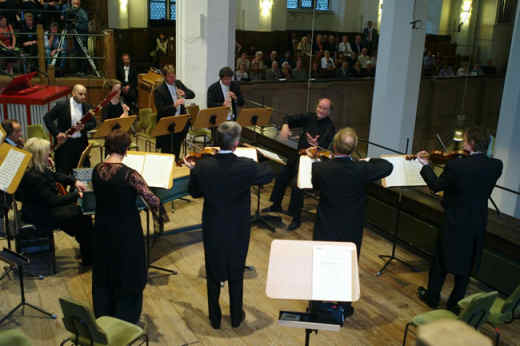
Sir
Roger Norrington and the German Chamber Philharmonic Bremen in
Bach’s First Brandenburg
Concerto in St. Thomas’s Church -
©Bach-Archiv Leipzig/Gert Mothes
Things worked much better in the symphonies in B and G minor.
Polish and brilliance suddenly returned, with a full-bodied sound combined
with suave grace, the many syncopations accenting the dissonant
clashes. The typical push-pull discourse came off very
well, with a host of wondrous felicities to be enjoyed. The
carefully built up tensions and contrasts, the sharply defined
rhythms and the bouncy energy were perfectly tailored in fiercely
brilliant sound. Incidentally, juicy thunderstorms ran through the
entire orchestra, as in the final Allegro molto of the G minor
symphony. The textual musical conflicts between Bach and his sons could not have been presented in any better or more convincing way.
One might argue that Norrington – and with him Harnoncourt for that
matter – tends to exaggerate accents and dynamics, occasionally
pushing the music in a kind of overdrive mode, but with such
hand-in-glove ensemble-playing it made an almost breathtaking
impression. And let us be frank: in a live performance more risks
may be taken than in a recording session, often with astonishing
results.
The performance of Mozart’s great symphony in E flat definitely put
the crown on the previous jewels. We got it all, from the highly
sensitive and affective phrasing and the splendid lift in the
thematic development to the most beautifully contoured woodwinds and
most distinctive string playing, consistently well balanced, with
the tremendous energy in this music perfectly laid out. As expected,
Norrington also made most of the merciless dissonances in the slow
introduction. The tensions on the rostrum must also have touched the
audience: no cough, no paper rustling, no other obtrusive noises
killed the utter concentration. After the concert had ended the
cheers broke lose. Norrington and the orchestra took it with their
biggest smile ever. Of course!
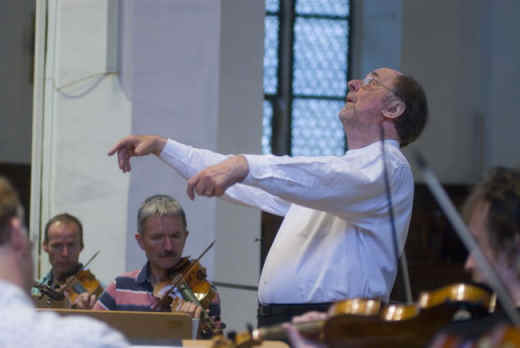
… and rehearsing Mozart’s Symphony No. 39 KV 543 in St. Thomas’s
Church
©Bach-Archiv Leipzig/Gert Mothes
A
thrilling performance by the Ensemble Raccanto in the Old Town Hall
First of all, the Old Town Hall (“Altes Rathaus”) is a place to
cherish. It is just one of those many impressive baroque venues in
Leipzig and Saxony that makes a visit there so rewarding
in itself.
But when a concert is played there too, as it was on that late Thursday
night, June 19th, there is really nothing more that one could
wish for
The Ensemble Raccanto was founded in 2005, as the fruitful outcome
of the close co-operation between organist and cembalist Robert
Schröter and the countertenor Andreas Pehl. They prefer to make
music on basis of special themes ike “A musical bird cage” with
baroque music rooted in the animal world or “Singing geography, a
trip through Europe”, when the ensemble members show themselves as
story tellers (“raccanto”) and singers (“cantare”), their goal being
to bring ancient music closer to the heart. The ensemble also writes
specific arrangements for their own use, a well-known practice in
the baroque period. Last year the first CD “Il Sassone” was released
with works by a.o. Hasse.
Their appearance in the Old Town Hall offered a mix of two very well
known pieces: Bach’s sacred cantata “Vergnügte Ruh, beliebte
Seelenlust” BWV 170, and Vivaldi’s Stabat Mater RV 621, together
with two much less familiar works: Hasse’s “Aurae placidae spirate”
and Melchior Hoffmann’s Symphony in F minor. Altogether a
fascinating sample-card of the ensemble’s musical and technical
skills, helped by the excellent acoustics of the modestly sized
“Festsaal” (festivities hall). The countertenor’s voice proved to be
in excellent shape, but his musical intelligence really swept
everybody away, demonstrating flair, refinement and eloquence in his
singing. Arrestingly crisp playing, with sensitive phrasing
balanced dynamics, and imaginative instrumental colouring further
emphasized the virtues of both the Raccanto and the small hall. One
could easily pick up numerous details in the strings (two violins,
viola, violoncello and violone) and the woodwinds (bassoon, oboe and
oboe d’amore). The silvery sound of the little organ was a delight
on itself.
The Cuarteto Casals in the Hall of Justice
The Madrid based Casals Quartet was established in 1997 and quickly
got worldwide recognition after winning a great number of awards in
Britain, Germany and Spain. They soon went global, with appearances in
all main concert halls all over the world. Those who have listened
to their CDs and live performances are familiar with the quartet’s
powerful lyricism and diversified string tone. But there is much
more, like their enchanting naturalness and sweetness of tone,
unrestrained clarity; in short the cumulative impact of their
interpretations and communicative powers. These are definitely not
musicians who still have to find their way in the classic, romantic
or contemporary repertoire. As soon as they start to play, the music
instantly catches fire. They build musical ideas with
great effect, the rubati are well measured, with hardly any
portamento to underline expressiveness. They let the music speak,
which leaves out mannerisms or self indulgence. There is always a discernible sense of proportion, a great variety in sonority and the
full understanding of the tonal implications as part of the music’s
structure. It all sounds heart rendingly spontaneous, but must
have been meticulously prepared.
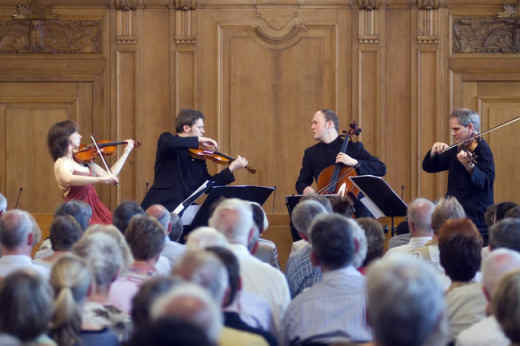
The Cuarteto Casals in the Hall of Justice
©Bach-Archiv Leipzig/Gert Mothes
The program on Friday, June 20, in the most impressive but uncomfortably hot court-room of the “Bundesverwaltungsgericht” (Hall of Justice) was carefully chosen: Schubert’s “Quartettsatz” in C minor D 703 (played without the slow movement’s 14 bars which Schubert abruptly broke off), Mendelssohn’s Quartet in A minor Op 13 and finally, after the interval, the last of Beethoven’s three Rasumovsky Quartets, in C major Op 59 No. 3. Each and every work was presented to striking effect, a demonstration of sheer brilliance and deep insight in the meaning and purpose of these great chamber works. The perfectly integrated themes in the “Quartettsatz” and their almost violent progression, or the effortless delivery of Mendelssohn’s virtuoso string writing, or the straightforward pulse and daring dynamics in the Beethoven were dressed in most colourful jackets, the slow movements getting under the skin. Moreover, the excellent acoustics and the consequential sharp sound definition contributed considerably to one of the best live performances of these quartets I had ever heard. Very compelling indeed, in terms of technical supremacy and musical insight.
A
quite different St. Matthew Passion in St. Nikolai’s Church
On November 3, 1767 Carl Philipp Emanuel Bach (already 53 at
that time) must have felt extremely happy: he finally got the job of
music director of the five main churches in Hamburg and cantor of
the Johnanneum school, as the successor to his godfather Georg
Philipp Telemann. At last, Bach’s second-eldest son could get out
of the suffocating court of Frederick the Second of Prussia, where
he served as a low-paid harpsichordist. In Hamburg he could spread
out his wings, take up a wide range of musical activities and
compose and conduct sacred and figurative music for all kinds of
occasions. This is what he wanted so much and what he finally got.
His previous attempts to leave his post at the court had all failed.
In 1750 he did not get the position of cantor at St. Thomas’s Church
in Leipzig as a direct successor after his father's death (who had died that
same year), aand he also failed to get that post again 1755, after Harrer’s death. He was equally unsuccessful in Zittau, in 1753.
Prior to his arrival in Hamburg he asked many questions od
Telemann’s grandson Georg Michael, at that time together with the
singer Schieferlein, the interim music director of church music in
Hamburg. He wanted to know from him whether a Passion was performed
there every year, and when. If so, was it performed in the
traditional way, with the Evangelist or other persona, or was it
arranged as a kind of oratorio, with reflections in the manner of
Ramler’s Passion music? On how many singers and instrumentalist
could he reckon with in those churches? Were all the customary
instruments available? Etc.
Alas, Georg Michael Telemann’s reply has not been preserved, but we
know that in Hamburg’s five main churches Passions were performed in
the traditional manner, with the Evangelist (the oratorio Passion),
on the Sundays before Easter. In the secondary churches Passions
could be either oratorio Passions or Passion oratorios in the style
of Ramler’s “Tod Jesu”. The annual oratorio Passion performances
followed the four-year cycle as per the Bible’s gospel sequence
(Matthew, Mark, Luke and John).
At the end of March 1768 Carl Philipp finally arrived in Hamburg. It
was too late to organize and conduct that year’s Passion (St. Luke
was on the desks this time). Georg Michael Telemann took over and
conducted one of his grandfather’s St. Luke Passions in the various
churches instead. The following year the St. John Passion would have
to be performed, but Bach broke the sequence and started his series
in Hamburg with a newly composed St. Matthew Passion (eventually, he
would conduct a total of 21 Passions there).
C.P.E. Bach’s St. Matthew Passions are based on three different
types of text. The basic libretto consists of the Bible verses from
Matthew (26 v. 36 to 27 v. 50 and are therefore shorter than the text as
used by J.S. Bach, i.e. Matthew 26 v. 1 to 27 v. 66). The second
type are the chorale texts, which are taken from the “Neu-vermehrtes
Hamburgisches Gesangbuch” hymnal. Carl Philipp notated the
four-part chorales without the text but added the respective number
and verse from the hymnal in the 1766 edition, just to facilitate
the copyists of the various parts. The third textual layer comprised
the madrigal texts of the choruses, arias and ariosi compiled
specifically for each Passion. These were conceived – with only one
exception – by Anna Luise Karsch (it is not clear whether the at
that time highly esteemed poetess, who lived in Berlin and was
acquainted with Johann Christian, delivered the text only to him).
The text of the aria “Wende dich, zu meinem Schmerz” was written by
Johann Joachim Eschenburg and Telemann had already used it for his St.
Luke Passion in 1764).
As with all of CPE Bach's further Passions, the 1769 Passion (H 782 in the
work catalogue) is in fact a compilation (pasticcio). Carl Philipp
took pieces from other works and various composers to create a new
entity, although a large part is originally his. It is true,
however, that the chorales, most of the turba choruses and the
chorale that concludes the Passion are his father’s, whereas one
turba chorus (“Weissage uns”) stems from a St. Mark Passion by
Homilius. Additionally, the Bible text recitatives are very strongly
linked with those in J.S. Bach’s St. Matthew Passion. On the other
hand, Carl Philipp drafted all the madrigal movements himself and apart
from the first chorus “Fürwahr, er trug unsere Krankheit” (a clear
rearrangement of the “Et misericordias” from his Magnificat) they
are all new compositions.
Although Carl Philipp composed his St. Matthew Passion (it lasts
about 100 minutes) specifically for the church performances in
Hamburg he presumably did not have the slightest idea at that time
that Passion performances as part of the church service were not
supposed to take more than an hour. He followed this rule in his
later Passions.
Nevertheless, this Passion is much smaller compared to his
father’s, and not only in terms of length. It has no vocal or
instrumental double chorus, but is drafted as a single-chorus piece
(in the case of J.S. Bach’s dual turba choruses in his St. Matthew
Passion, such as “Der du den Tempel” and “Andern hat er geholfen”,
Carl Philipp got around it by having chorus I played by the
instrumentalist ensemble). Also, he had only eight singers and
sixteen to eighteen instrumentalists at his disposal.
Carl Philipp’s extended use of the pasticcio model raises questions
about the originality of his Passion compositions. However, it needs
to be
emphasised that each one of them maintains its own original
character, mostly because he always substituted the madrigal
movements in any new Passion with new ones he had drafted. No Passion
was just plainly repeated from one year to the next. Unlike the
twenty subsequent Passions, which were only performed in their
respective years, the movements from the 1769 Passion lived on in
his Passion Cantata Wq 233/H 766, which, unlike the 1769 Passion,
was performed for many years in and far beyond Hamburg. This music,
solely composed by Carl Philipp, was one of the most widely
distributed and most frequently performed of all his works during
his lifetime, perhaps
because in the second half of
the 18th century, oratorio Passions were generally considered
antiquated and obsolete, while Passion oratorios enjoyed much great
popularity. It is no coincidence that with the posthumous
performance of the St. Matthew Passion in 1789 (Carl Philipp had
died the previous year), the tradition of oratorio Passions
also came to
an end in Hamburg.
The glowing
performance in St. Nikolai’s Church on Friday evening, June 20,
reflected dramatic theatre and musical beauty, with
all those undertones
from which the also musically genetic connection between the father
and the son clearly emerged. The Evangelist, the emotionally driven
tenor Julian Podger, had to work himself through his role in almost
overtime fashion (he has much more to say than in J.S. Bach’s St.
Matthew Passion), but his understanding of the text together with
his agile expression caught everyone’s attention. His was not just a
reporter’s role, as he stood there as a real human narrator
who was
emotionally engaged in what he was singing. The opulent bass voice of Tobias Scharfenberg
(Jesus) did not assault the ear but emphasised musical depth,
immersed in impressive restraint and clarity. Another highlight was
the chorus member Hermann Oswald in the various tenor soli. He mixed
tragedy with wonder, indisputably a master in his different roles,
perfectly adapting his voice to events as they unfolded. The Balthasar-Neuman Chorus and instrumentalists (two oboes, two flutes,
two horns, two bassoons, timpani, strings and basso continuo) were
all second to none, commandingly embracing the imaginative score and
handling the high and low tessitura with impressive assurance.
Choral virtuosity and articulation were embedded in the
progressively dramatic course of events. There was that magical mix
of mellow resonance and sharp definition. Conductor Ivor Bolton did
not leave any doubt about his allegiance to Bach’s scoring. His
detailing was just amazing, with superb shading and continuously
pointing to well proportioned diction and dynamics, in well judged
tempi. He presented the kind of brilliancy this a work needs and
deserves, grasping and keeping the attention from start to finish.
All were rewarded with loud and sustained cheers by a fully packed
house.
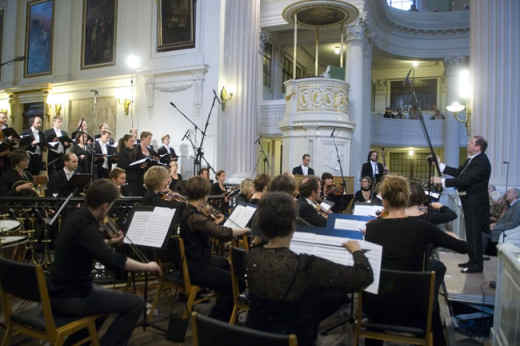
St. Nikolai’s Church: Ivor Bolton leads the
Balthasar-Neumann Choir and Ensemble in the St. Matthew Passion by
Carl Philipp Emanuel Bach
©Bach-Archiv Leipzig/Gert Mothes
The Goldberg Variations in the Gewandhaus
There is
the frequently returning question about the instrument to be used in
Bach’s Goldberg Variations, originally written for cembalo. The work
was most probably intended to be the last part of Bach’s “Clavier-Übung”.
Whatever the
original preferences, many of us are familiar with stunning piano
performances by for instance Glenn Gould, András Schiff, Murray
Perahia and Angela Hewitt. For sure, Bach’s music does not
collapse under the weighty tone of the grand piano.
Evgeni
Koriolov (Moscow 1949, but living in Hamburg) is a pianist with many
important prizes behind him, his repertoire ranging from Bach to
Debussy, Messiaen and Webern. He is also active in chamber music,
with partners like Natalia Gutman, Mischa Maisky, the Auryn and the
Keller Quartets. He forms a piano duo with his wife Ljupa
Hadzigeorgieva.
Late that
evening, on Friday, June 20, just prior to Kiorolov’s appearance,
part of the audience in the Mendelssohn hall of the Gewandhaus was
more or less in turmoil. The recital was to be recorded on video for
NHK in Japan, which required the use of dazzling lights mercilessly
directed at the public. The opposition was loud and clear: “This is
music for us, not for television,” and “We did not pay for this
distraction.” It was all a little bit over the top as those lights
were only to be turned on at just a few instances, at the beginning
and at the end of the concert, to allow the camera team to make a
few snapshots of the applauding audience in the otherwise dimmed
concert hall. After this became clear, tranquillity returned.
Kiorolov
finally appeared on the podium, the lights were dimmed and the
recital began. He first disappointed in the very slowly paced 32
bars of the introductory aria, no matter how beautifully he moulded
each and every note. He lingered too much, definitely trying to make
as much as possible out of them. But when the first variation went
off, his playing gained momentum, the music strictly kept within its
own expressive boundaries. Kiorolov’s ability to unlash each
variation’s specific character by way of tempo and touch made this a
highly rewarding listening experience after all (the additional
bonus: the great sounding Steinway Grand was perfectly tuned). His
Bach resonated in a most idiomatic interpretation that did all
justice to the incidentally very complex counterpoint, consistently
underpinning the expressive nature of the music. Fresh and beguiling
in the quick movements, finding the depths in the slow ones, with
all the panache and proficiency one could possibly ask for. At the
end, after the 30th variation, Kiorolov repeated the
aria in a slightly quicker tempo. Full circle in one of the greatest
instrumental masterpieces of the 18th century.
Click Here for Part Three
Aart van der Wal
